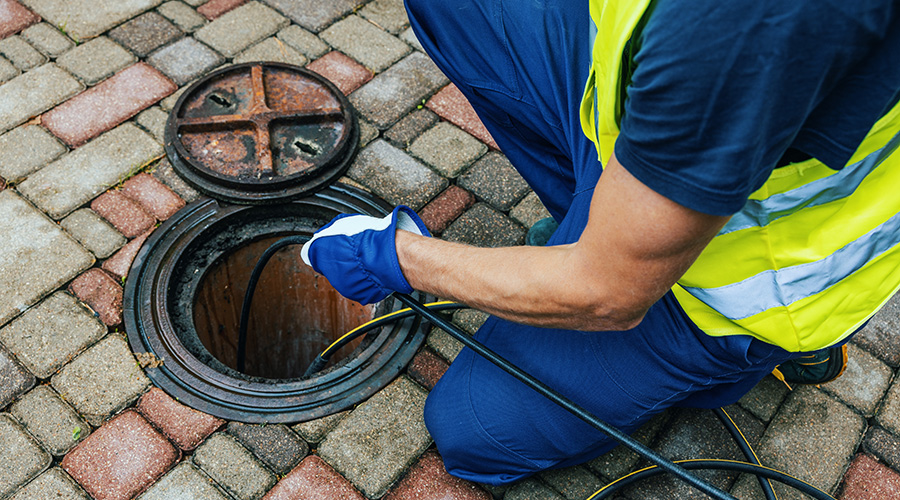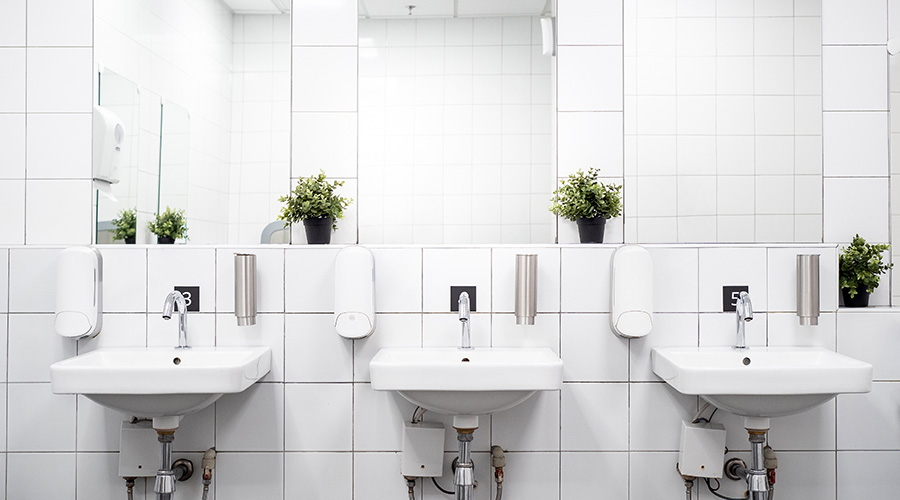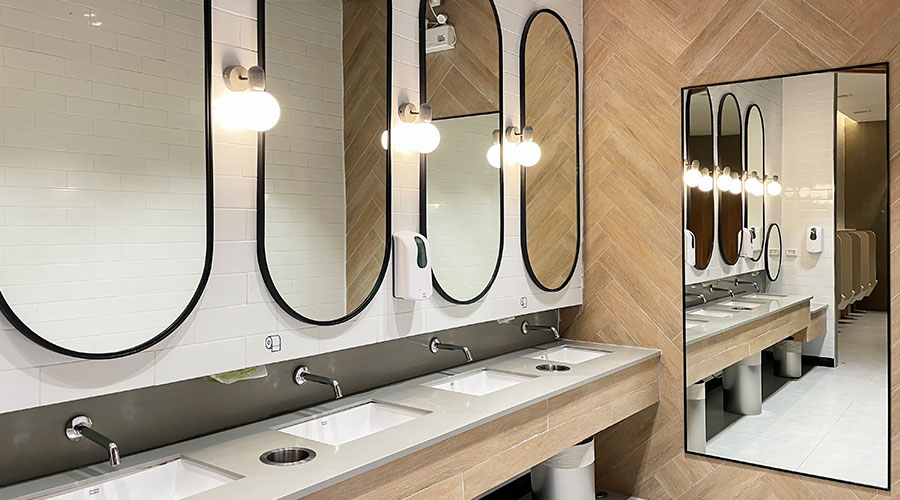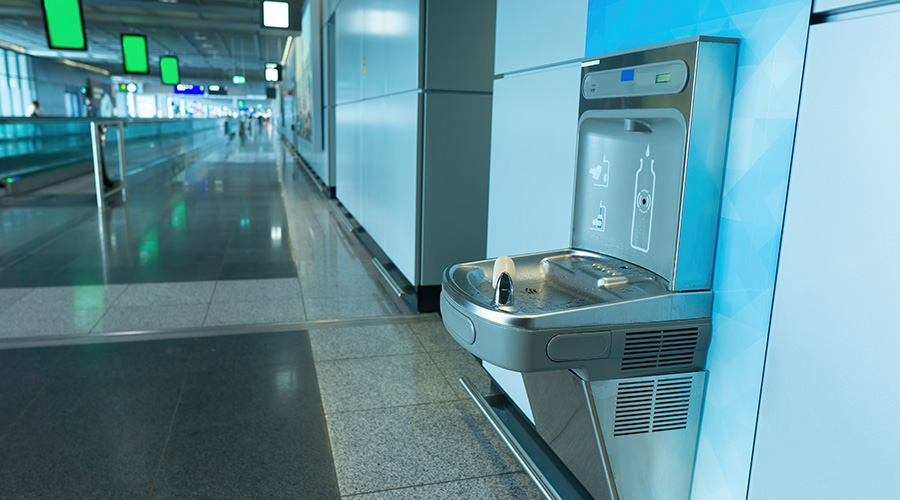Lavatory Faucet and Hand Dryer Considerations
When considering faucets, the fixture should match the use. Lavatory faucets are primarily used for hand-washing and some light bathing (face washing, shaving or tooth brushing), while sink faucets are used for utensil washing, culinary, cleaning, laundry, scrubbing or building maintenance. Building design teams must match the proper low-flow lavatory faucet with the correct application.
Lavatory faucets are used in three broad categories of applications. The first is hand-washing in public restrooms, where most codes require the flow rates to be 0.5 gallons per minute (gpm).
The next category is private fixtures used for moderate hand-washing and light bathing. Codes usually refer to these facilities as private lavatories, and fixtures using 1.8 gpm or less typically are specified. Faucets that use more than 1.8 gpm aren't appropriate for private restrooms.
The third category is private fixtures used for heavy hand-washing, such as medical, culinary and maintenance. In these applications, more water is required, so 1.8 to 2.2-gpm fixtures can be used. However, most codes restrict these fixtures to less than 2.2 gpm.
In most cases, the water doesn't have to remain flowing during scrubbing. If this is true, sensor-, foot-, or knee-operated fixtures can be specified. The user turns the water on only when rinsing is required. It is important to note these fixtures are exempt from the LEED energy and water calculations in some situations. This is particularly true for clinical applications.
Lavatory Faucet Options
Low-flow lavatory faucets are readily available in many price ranges and options. Water use is reduced in some fixtures with a simple flow restrictor in the spout, which can be removed easily. Better-made fixtures integrate the flow-restricting device into the fixture itself. Manual and electronic metering fixtures that control the amount of time a fixture operates are available and recommended in public installations.
Sensor-activated valves are available as battery-operated, hard-wired, hydro- and solar-powered options. Some manufacturers have batteries designed to last 30 years.
The quality of battery-operated fixtures is improving, and they may be the best application for some facilities. Operators will have to develop a battery-changing schedule to prevent failure.
While studies have shown that sensor-activated faucets use more water than manually activated faucets, they do provide sanitary benefits that generally outweigh the additional water used.
Many options for temperature control are available. Fixtures where the user sets the temperature above the counter are recommended where staff will be using the fixtures. In health care facilities, the staff will appreciate a touchless control feature. Public restroom users usually don't notice the temperature control and seldom use it. Public fixtures also require a temperature-mixing valve to reduce the maximum hot water temperature.
Before installing faucets with flow rates of 0.5 to 1.8 gpm as standard fixtures, facility managers should try them out to ensure they meet the organization's approach to sustainability and efficiency. When sensor operated fixtures are used, it is important to coordinate cleaning chemicals and methods, so sensor lenses won't be damaged and fail.
Winston Huff CPD, LEED AP is a project manager, plumbing designer and LEED facilitator with 25 years of experience is at Smith Seckman Reid Inc.. He is also president of Science Interactive and Me Green You Green that promotes building systems that respect the biosphere. Huff can be reached at whuff@ssr-inc.com.
Touchless Fixtures for Hygiene and Green
Due to concerns about hygiene and contagious diseases, more and more facility managers are opting for touchless fixtures in restrooms. This often leads to a debate about whether to use hand dryers or towels. The key to making this decision, say experts, is simply matching the option facility managers feel fits best with their facility types, occupant habits and the requirements of their individual restroom facilities.
Whichever option facility managers choose, going touchless means keeping a few considerations in mind. One of the most important criteria facility managers should consider is how their choices affect their overall envirotnmental goals.
High-speed hand dryers, some studies have shown, can cut the carbon footprint of restrooms by up to 70 percent, depending on the type of dryer selected. Facility managers can choose from nozzle vs. hand-dip (where users actually insert their hands into the dryer) types. Newer model hand dryers also are 80 to 90 percent more energy efficient than their predecessors, says Thomas Westerkamp, CEO and managing partner of Productivity Network Innovations, a consulting firm that specializes in facility and maintenance management. Other considerations include drying time and noise levels. Many newer high-speed dryers on the market can cut hand-drying time in half — from 20 to 30 seconds to 10 to 15. Most manufacturers offer accessories that can help abate noise, says Westerkamp.
Hand dryers may also cut maintenance requirements for restrooms, as facility managers aren't having to send staff to clean up "missed shots" around the waste receptacles.
But if occupants are more comfortable with towels, many manufacturers have taken care to secure green certifications for their products, such as with the Forest Stewardship Council or Sustainable Forest Initiative, which ensure sustainable forestry practice. Many manufacturers also use a high percentage of recycled paper in the towels. Westerkamp says high recycled content should be a key part of facility managers' specifications.
Additionally, Green Seal is working to combine its two paper product standards (GS-1 and GS-9) into a single standard GS-1 Sanitary Paper Products. The new standard would recognize products that meet environmental life-cycle criteria, including the use of chlorine and other hazardous materials during production; water and energy use during production; air and water-quality emissions from production; transportation-related emissions; waste; packaging; and social responsibility. Products also must meet performance criteria for several characteristics, including basis weight, wet and dry tensile strength, stretch, water absorbency, and brightness.
Selecting products that meet these green certifications helps ensure that facility managers can conform to their organizations' environmental goals. And whether facility managers elect to use tri-fold towels or rolls, manufacturers have produced several options for touchless dispensers for either.
— Greg Zimmerman, executive editor
|
Related Topics:













